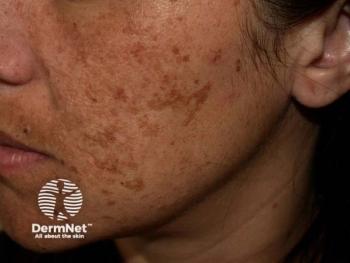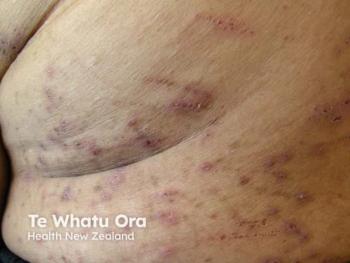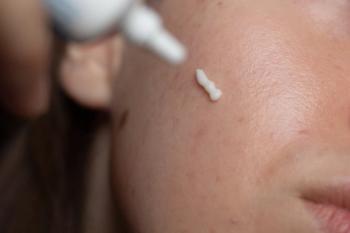
Molecular Insights Into ICI-Induced Skin Toxicities

Key Takeaways
- ICIs can cause cirAEs, with Th1, Th17, and Th22 pathways activated in ICI-associated dermatitis, suggesting unique immune mechanisms distinct from idiopathic conditions.
- Molecular profiling identified IL4R and JAK3 as potential therapeutic targets, supporting the use of pathway-directed treatments like dupilumab and JAK inhibitors.
Cutaneous immune-related adverse events (cirAEs) from immune checkpoint inhibitors (ICIs) show distinct immune profiles from classic skin conditions.
Immune checkpoint inhibitors (ICIs) have revolutionized oncology by harnessing the immune system to fight cancer. However, their immune-enhancing effects extend beyond tumor control and can trigger immune-related adverse events (irAEs) in nearly any organ. Cutaneous irAEs (cirAEs) are the most common, affecting up to 60% of patients, and encompass a variety of inflammatory skin reactions, including eczematous and lichenoid eruptions. These dermatologic toxicities can impair quality of life and sometimes necessitate permanent discontinuation of lifesaving cancer therapy. Despite their frequency, the underlying immunopathology of cirAEsremains poorly defined, hindering development of targeted therapies and often resulting in reliance on systemic corticosteroids, which may blunt antitumor responses.1
A recent study used a minimally invasive technique, tape strip RNA sequencing, to characterize the molecular signatures of ICI-associated eczematous dermatitis (ICI-Ecz) and ICI-associated lichen planus (ICI-LP), comparing them to atopic dermatitis (AD) and healthy controls (HCs). Samples were obtained from lesional and nonlesional skin, enabling insights into immune activity both at and beyond clinically apparent disease.2
Key Findings
The study revealed substantial upregulation of Th1-associated genes in both ICI-Ecz and ICI-LP, particularly in lesional skin. Genes such as CXCL9, CXCL10, CXCL11, MX1, and OASL showed significantly higher expression in ICI-LP and ICI-Ecz compared to HCs and even AD, supporting prior research suggesting that ICIs expand tissue-resident memory T cells, amplifying IFNγ-driven Th1 responses. Researchers said this Th1 dominance was most pronounced in lesional ICI-LP and was also present in nonlesional skin, indicating broader immune activation even in clinically unaffected areas.
Th17 and Th22/IL-22 pathways were also activated, particularly in lesional ICI-Ecz and AD, with elevated expression of PI3, S100A7/8/9, CXCL1/2/3, and CCL20. In contrast, nonlesional ICI-Ecz lacked such upregulation, suggesting more localized immune dysregulation. These findings align with serum studies in ICI-treated melanoma patients, which demonstrated increased IL-17A and IL-22 in those who developed cirAEs, and support the potential relevance of IL-17/23 blockade for treating select ICI-induced dermatoses.
Interestingly, the study identified IL4R upregulation—a key Th2 marker and target of dupilumab—in both lesional ICI-Ecz and ICI-LP. The study stated this was more restricted than in AD, where broader Th2 dysregulation was noted, including in nonlesional areas. These data provide molecular support for the successful use of dupilumab in treating cirAEs without compromising ICI efficacy, a finding supported by ongoing clinical trials and case series.
JAK-STAT Pathway Activation and Therapeutic Implications
Significant JAK3 upregulation was observed in lesional ICI-Ecz, while AD samples exhibited broader upregulation of JAK3, STAT3/4/5A/5B. GSVA confirmed IL-6/JAK/STAT3 pathway enrichment in both ICI-Ecz and ICI-LP. These findings underscore the potential for selective JAK inhibitors as therapeutic options in refractory cirAEs. However, systemic JAK inhibition carries risks in patients with cancer and must be approached cautiously. Topical agents such as ruxolitinib may offer safer alternatives, with early evidence of efficacy in steroid-refractory ICI-Ecz.
Clinical Relevance and Future Directions
This study enhances our understanding of the immunologic landscape of cirAEs, revealing overlapping but distinct molecular profiles compared with classic inflammatory dermatoses like AD. The data suggest that cirAEs are not merely mimics of idiopathic conditions but are driven by unique immune mechanisms, particularly Th1-centric inflammation possibly rooted in ICI-induced tissue-resident memory T-cell expansion.
Furthermore, the identification of druggable targets such as IL4R and JAK3 supports the feasibility of pathway-directed treatments that spare systemic immunosuppression. Clinical use of dupilumab, ruxolitinib, and IL-17/23 inhibitors has shown promise in small studies and case reports, and larger trials are warranted to validate their safety and efficacy in the ICI-treated population.
One key limitation is the small sample size and the inherent depth constraints of tape stripping, which may not capture deeper immune activity. Additionally, spontaneous lichen planus samples were not included, limiting molecular comparisons to idiopathic lichenoid disease.
Conclusion
Cutaneous irAEs such as ICI-Ecz and ICI-LP are immunologically distinct from their idiopathic counterparts, characterized by robust Th1 skewing, selective Th2 activation, and variable Th17/22 involvement. These findings inform a growing rationale for precision medicine approaches in oncodermatology—tailoring treatments based on molecular profiles to minimize toxicity while preserving antitumor efficacy. Researchers stated further research is needed to elucidate the drivers of cirAE susceptibility and to translate transcriptomic insights into targeted clinical interventions.
References
- Quach HT, Johnson DB, LeBoeuf NR, Zwerner JP, Dewan AK. Cutaneous adverse events caused by immune checkpoint inhibitors. J Am Acad Dermatol. 2021;85(4):956-966. doi:10.1016/j.jaad.2020.09.054
- Powers CM, Kim M, Chang A, et al. Tape strip profiling of checkpoint inhibitor-associated dermatitis highlights pan-T-cell activation: A pilot study. JID Innov. 2025;5(4):100375. Published 2025 May 5. doi:10.1016/j.xjidi.2025.100375
Newsletter
Like what you’re reading? Subscribe to Dermatology Times for weekly updates on therapies, innovations, and real-world practice tips.


















